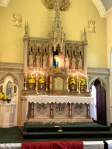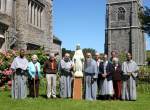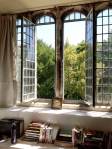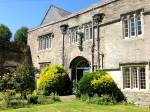
I write this post from my where I am now assigned as chaplain to our contemplative sisters in Lanherne, St. Mawgan in the County of Corwall in England. I am taking the place of Fr. George Mary Roth, who has faithfully served the sisters and the local people of Cornwall for nine years. His departure is deeply felt by all and he will be sorely missed. May God reward him for all the good he has done here. May Our Lady keep him under his mantle along the path on which She guides him.
The picture above is the front yard of the friary which is at the left (click on the photo for a larger file). Actually the front of the building as you see it is the extern quarters to the convent of our contemplative sisters who occupy the much larger part of the building.
The property of the convent lies in a valley through which formerly ran a river. It is a approximately a mile and a half from the sea at St. Mawgan Porth, which can be reached from a footpath nearby.
Christianity arrived in Cornwall in the 5th century, at places like Lanherne, at what became various monastic centers situated around the area. That was at the time of the legendary Arthur Pendragon, who is said to have been born in Tintagel, which is about a half hour north of here on the coast, where the friars play tennis once a week with a local priest and friend, Fr. Brian Storey. Glastonbury, or the legendary Avalon is about one hundred miles to the north.
Celtic monks founded a monastery at Lanherne in the 6th century the site of the present convent, which later came into the possession of the bishops and still later of the great English noble family of Arundell. The present building is the medieval Manor House of the Arundells, which is the center of Catholicism in the area. The estate provided work for many people and the family built the Medieval Church of St. Mawgan which you can see in the background of the picture above. The parish church is now in the possession of the Church of England and the convent is separated from the church property by an ancient wall.
The Arundells remained a faithful Catholic family that suffered terribly throughout the period of the English Reformation. They used the manor house to hide Catholic priests, who were in threat of certain death if captured. Not least of these courageous priests was St. Cuthbert Mayne, who was eventually captured nearby at and hung drawn and quartered at Launceston, his quarters being sent to the four corners of the realm, his head being placed on a pike. The top of his scull is in the possession of the convent and is venerated here every Sunday after Mass. One can clearly see the hole in the top of the cranium from where his head was placed on the pike.
Local historians know more or less where the hiding places for priests (priest holes) were built into the manor house walls. One of them is believed to be in the present chapel of the friars, though modern paneling currently prevents its definitive discovery.
The Manor House was also a way station along the route of the Welsh pilgrims to St. James of Compostella. The scallop shell of St. James is engraved in stone above the front door.
In 1794 the Manor House was offered by the Arundell family to a group of English Carmelite nuns who were fleeing France because of the persecution of the French Revolution. From that time until fifteen or so years ago the Manor house has been a carmelite monastery. The Franciscan Sisters of the Immaculate took it over and it remains the place of their enclosure as contemplatives consecrated unlimitedly to the Immaculate.
Land of Saints
If one considers the whole length of history of Lanherne from the earliest Christian times when monasticism was developing and becoming the means of spreading the faith, to the period of the Middle ages in which a great Catholic family provided the means for the local people to live a life of faith in peace, to the time of the persecution of the Church, when the same family made sure that priests were protected and the Sacraments continued to be made available to the people, to the time of restoration in which contemplative nuns rekindled the fire in a place hollowed by holy men and women who suffered and bled for Christ, then one can come to appreciate what an important place Lanherne is to the Catholic Church in England. Indeed, the Holy Sacrifice of the Mass has been celebrated here continuously since the foundations of Christianity in England, even during the penal times. It is perhaps the only place in England where Jesus in the Eucharist has had such a continuous and enduring presence.
Cornwall is known as the Land of Saints because of the numerous places throughout the county that are named after saints, most of them very ancient local saints. England, like so many other places in the Western World has had a lapse in its Christian memory. But England in particular, as Our Lady’s Dowry, is particularly haunted by the ghost of Catholicsm. It is everywhere present, but often stands almost unnoticed as though it was invisible. However, the fire kindled by the saints remains alive. An ancient building may merely be a monument to past ages, or it may be a meeting place of multiple generations of men and women who pass on the flame. To think I pray each morning in a room that one day long ago may have been searched by the enemies of the faith, and behind a hidden panel in the wall a saint, and soon to be martyr, held his breath lest he be discovered! May we never forget! May we never allow ourselves the pitiable luxury of forgetting the true cost and value of Jesus present in the Blessed Sacrament.


















